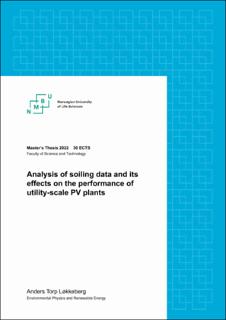| dc.contributor.advisor | Olsen, Espen | |
| dc.contributor.advisor | Haug, Halvard | |
| dc.contributor.author | Løkkeberg, Anders Torp | |
| dc.date.accessioned | 2022-08-15T10:44:41Z | |
| dc.date.available | 2022-08-15T10:44:41Z | |
| dc.date.issued | 2022 | |
| dc.identifier.uri | https://hdl.handle.net/11250/3011834 | |
| dc.description.abstract | Gjennom de siste årene har solenergi fått et løft politisk, teknologisk og sosialt. Høye elektrisitetskostnader, globale katastrofer og klimaendringer har lagt grunnlaget for satsingen på elektrisk kraftproduksjon fra solenergi. For stor-skala solcelleanlegg er effektiv drift og vedlikehold avgjørende for lønnsomhet. Formålet med denne oppgaven er å finne meningsfull informasjon i tilsmussingsdata fra målestasjoner for stor-skala solcelleanlegg. Forskningsspørsmålet er formulert som følger: Hvordan kan tilsmussingsdata bli filtrert og analysert for å bestemme smuss-situasjonen og dens effekt på ytelsen av et stor-skala solcelleanlegg? Hovedmålet med oppgaven er å finne estimater for daglig tilsmussingsgrad i de forskjellige solcelleparkene. Dette innebærer å utvikle metoder for å bedre differensiere mellom god og dårlig datakvalitet. I tillegg blir forholdet mellom tilsmussingsgrad og korrigert ytelsesgrad i parken undersøkt. Avslutningsvis blir effekten regn har på vasking av panelene undersøkt. Gjennomgående metode i avhandlingen er filtrering og korrigering av datasett, samt diverse statistiske og matematiske analyser sett opp mot eksisterende teori. Hovedfunnene viser daglige tilsmussingsgrader på i snitt, 0, 12 ± 0, 01 %, 0, 135±0, 006% og 0, 047±0, 006% for solcelleanlegg i Sør Amerika, Nord Afrika og Sør Afrika respektivt. I tillegg blir det funnet lite korrelasjon mellom tilsmussingsnivå og ytelsesgrad, noe som tyder på tilstedeværelse av andre uoppdagede ytelsesbegrensende hendelser. Det blir også funnet at daglig nedbør mellom 3, 3mm og 4, 2mm er tilstrekkelig nok til ˚a holde tilsmussingsgraden mellom 1, 0% og 1, 5% i Sør Amerika. For videre forskning vil forbedring av datakvalitet og innsamling av data være en prioritering. I tillegg blir det foreslått en automatiserbar metode som også ville vært interessant å utforske videre. Siden tilsmussing av solcellepaneler kan redusere energiproduksjon betydelig, er videre forskning på dette feltet avgjørende for solcelleteknologiens fremtid. | en_US |
| dc.description.abstract | In recent years, solar energy has received a major boost politically, technologically, and socially. High electricity costs, global disasters and climate change has has laid the foundation for a global interest in investments in electric power production from solar energy. For utility-scale photovoltaic systems, efficient operation and maintenance are crucial for profitability. The purpose of this dissertation is to find meaningful information in soiling data from dedicated measuring stations for utility-scale photovoltaic systems. The research question is formulated as: How can soiling station data be filtered and analyzed to determine the soiling situation and its effects on the performance of a utility-scale PV plant? The main goal of this thesis is to find estimates for the daily soiling rates in the various PV plants. This includes developing filters to better differentiate between good and poor data quality. In addition, the relationship between the soiling level and the corrected performance ratio in several plants is examined. Finally, the effect of rainfall panel cleaning is investigated. The general method in the dissertation is filtration and correction of data sets, as well as various statistical and mathematical analyzes, seen in the context of existing theory. The main findings are daily soiling rates of, on average, 0.12 ± 0.01 %, 0.135 ± 0.006% and 0.047 ± 0.006% for utility-scale PV plants in South America, North Africa, and South Africa respectively. In addition, little correlation is found between the soiling level and the corrected performance ratio, which strongly indicates a presence of other performance-limiting events that were undetected. It is also found that daily rainfall between 3.3mm and 4.2mm is sufficient to keep the soiling rate between 1.0% and 1.5% in South America. For further research, improving data quality and collection would be an important priority. In addition, an automatable method is proposed that would also be interesting to explore further. Since the soiling of solar panels can greatly reduce production, further research in this field is crucial for the future of this technology. | en_US |
| dc.language.iso | eng | en_US |
| dc.publisher | Norwegian University of Life Sciences, Ås | en_US |
| dc.rights | Attribution-NonCommercial-NoDerivatives 4.0 Internasjonal | * |
| dc.rights.uri | http://creativecommons.org/licenses/by-nc-nd/4.0/deed.no | * |
| dc.title | Analysis of soiling data and its effects on the performance of utility-scale PV plants | en_US |
| dc.type | Master thesis | en_US |
| dc.description.localcode | M-MF | en_US |

